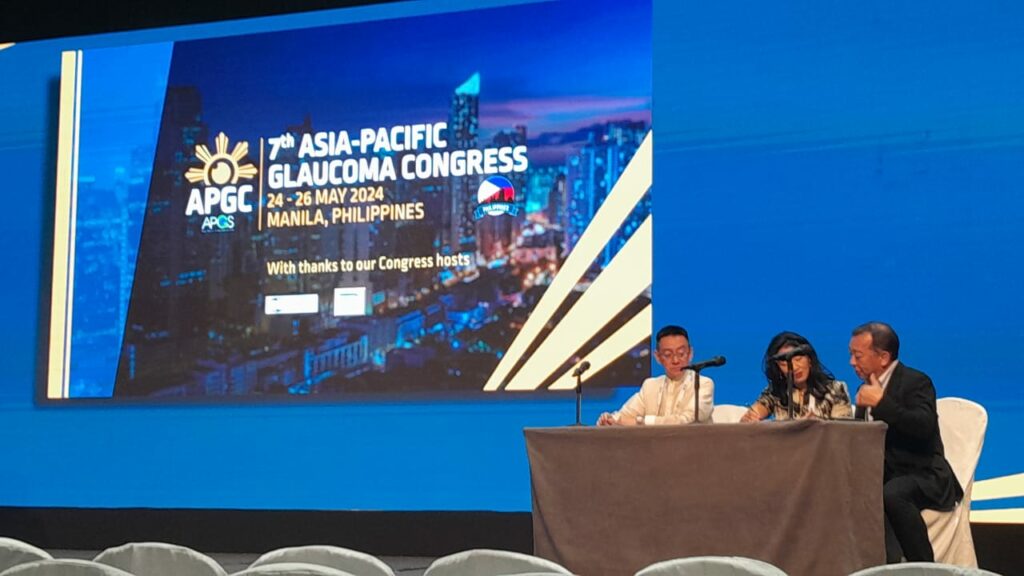Symposium Three on Day One at the 7th Congress of the Asia-Pacific Glaucoma Congress (APGC 2024) in Manila illuminated a path of innovation and hope. Under the theme Glaucoma Therapies: what’s new and what’s on the horizon? global experts explored groundbreaking advancements poised to transform the landscape of glaucoma care.

New IOP-lowering eye drops
The session unveiled a promising array of eye drops aiming to control intraocular pressure (IOP), a key factor in managing the condition. Dr. Shan Lin from the Glaucoma Center of San Francisco (USA) delved into the potential of latanoprostene bunod, a fusion of prostaglandin and nitric oxide components targeting both uveoscleral and trabecular outflow pathways.
According to Dr. Lin, this novel compound showcased significant efficacy in IOP control during the APOLLO and LUNAR phase 3 trials, outperforming timolol with approximately 80% of patients achieving a 30% (or greater) reduction in IOP.1
Even patients with normal tension glaucoma (NTG) who were treated with latanoprostene bunod saw a substantial 26% IOP reduction in the JUPITER study.2
Dr. Makoto Aihara from the University of Tokyo (Japan) shared insights on omidenepag isopropyl (OMDI), an EP2 receptor agonist marketed as EYBELIS®. Like latanoprostene bunod, OMDI also enhances outflow through both the trabecular and uveoscleral pathways.
Notably, the FUJI study found that latanoprost non-responders experienced a significant IOP reduction when switched to OMDI.3
From Duke University, Dr. Sanjay Asrani (USA) presented advancements with the rho kinase inhibitor, netarsudil. Explaining its mechanism, he said, “This new development relaxes trabecular meshwork cells by reducing actin stress fibers, increasing aqueous outflow, reducing aqueous production, and uniquely, lowering episcleral venous pressure.”
Essentially acting like a “drain cleaner” for the eye, netarsudil consistently lowered IOP by 3.7 to 4 mmHg in the ROCKET studies.4
Dr. Asrani underscored the potential of combining netarsudil with other medications, which yielded impressive results in lowering IOP without significant local or systemic side effects.5,6,7
Thanks to COVID
The groundbreaking work by Dr. Tina Wong from the Singapore National Eye Centre and Dr. Cynthia Yu-Wai-Man of King’s College (United Kingdom) mirror unique properties of the COVID-19 vaccine.
Dr. Wong tackled the non-compliance issue with eye drops, emphasizing the critical need for alternative drug delivery methods. “The majority of patients still forget to take their eye drops. If you’re not putting them in properly, they’re not going to work,” she noted.
This challenge has paved the way for innovative solutions like liposomal nanocarriers, capable of delivering both hydrophilic and hydrophobic drugs. Dr. Wong highlighted their versatility and safety by pointing to the COVID-19 vaccine, which utilizes similar technology:
“One example of a nanoliposome sustained release carrier is the COVID vaccine. And so, we know that liposomal nanocarriers are safe, and the FDA has approved them.”
In her research, Dr. Wong’s team developed a latanoprost-sustained nanoliposome formulation that showed significant IOP reduction in clinical trials. However, lymphatic clearance from subconjunctival injections limited the drug’s residency time, leading them to explore the suprachoroidal space (SCS) as an alternative route.8
Dr. Wong reported that preliminary experiments were promising, with sustained IOP reduction for up to two months and minimal retinal impact.
Meanwhile, Dr. Yu-Wai-Man captivated attendees with her presentation on non-viral gene therapy, leveraging the success of mRNA technology seen in COVID-19 vaccines. “None of this would have been possible without the lipid nanoparticle,” she remarked.
While viral gene therapies like Luxturna® have shown promise, they come with significant drawbacks, including immune reactions and limited applicability for glaucoma patients.
Enter LipTide®, a novel non-viral gene therapy vehicle developed by Dr. Yu-Wai-Man’s team. Composed of lipid, peptide and payload components, LipTide is customizable for specific therapeutic needs.
“The advantage of LipTide is that every part can be customized for purpose,” she stated, allowing for targeted treatment and reduced risk of immune reactions.
Preclinical trials using LipTide in glaucoma filtration surgeries on rabbit models showed remarkable results, doubling bleb survival to 22 days without the toxicity associated with current standards like mitomycin-C.
Affordable glaucoma implant
Dr. Andrew White from Westmead Hospital (Australia) presented a groundbreaking and cost-effective glaucoma implant with drug-eluting properties. He highlighted the urgent need for affordable glaucoma solutions, noting, “The cost of glaucoma treatment, especially surgical treatment, can be prohibitively expensive.”
The new implant, made from readily available corrugated abdominal drains and cannulas, is simple yet effective. The multiple-lumens design creates a valve effect, ensuring that the implant adapts to varying eye pressures without the risk of hypotony.
One of the implant’s key advantages is its ability to sidestep the regulatory process that often accompanies new medical devices. “This is stuff off the shelf, and it’s used off-label. It doesn’t have regulatory hurdles because these are already approved materials,” he explained.
Initial tests in canine models, which suffer from severe glaucoma, showed promising results. “We had 17 eyes of 14 canines where we followed up for usually at least a year,” Dr. White reported. The implants effectively reduced intraocular pressure.
Dr. White then shared an inspiring case of a human patient who benefited from this innovative implant after conventional treatments failed. The patient’s humor about being a pioneer—”He thought it was hilarious that this had only been tried on dogs before”—underlines the innovative spirit driving this research.
Exploring molecular frontiers
Dr. Sushma Tejwani from Narayana Nethralaya-2 (India) presented her team’s investigation into the intraocular molecular status of glaucoma patients to identify biomarkers that could predict and influence disease progression and response to medication.
By examining trabecular meshwork samples from patients with primary open-angle glaucoma (POAG) and primary angle-closure glaucoma (PACG), Dr. Tejwani’s research highlighted significant fibrotic markers such as TGFbR2 and fibronectin, which were altered based on disease severity.9
The study also explored the impact of common glaucoma medications, like prostaglandins and beta-blockers, on these fibrotic markers. Dr. Tejwani revealed, “There was decreased pro-fibrotic gene expression by using this combination,” suggesting an additional benefit of these drugs beyond IOP reduction.9
By analyzing 52 isolated molecular factors in aqueous samples, her team identified distinct patterns associated with disease progression, medication response and surgical outcomes.
Summing up her findings, Dr. Tejwani stated, “There was a distinct molecular pattern that was seen in responders and non-responders and also in progressors and non-progressors.” This breakthrough paves the way for targeted modulation of drugs and surgeries.
Neuroprotective therapies
Dr. Qing Wang from Columbia University (United States) shed light on the promising future of neuroprotective therapies for glaucoma.
She explained that neuroprotective therapies involve preserving neuronal structure and function, specifically targeting retinal ganglion cells lost in glaucoma. This approach aims to prevent axonal loss and cell death, a critical advancement since current therapies mainly target IOP.
Dr. Wang highlighted a breakthrough with nicotinamide and pyruvate, which have shown strong neuroprotective effects in animal models by improving mitochondrial function and energy metabolism.
“Nicotinamide supplementation prevented NAD decline and exhibited neuroprotective properties,” she shared, referencing studies where this combination enhanced nerve protection significantly.10,11
These findings have been supported by a small randomized controlled trial at Columbia, showing notable improvement in visual function for glaucoma patients.12
“There’s already been excitement about nicotinamide as a neuroprotective therapy,” she said, noting ongoing trials worldwide.
Reporting for this event took place during the 7th Congress of the Asia-Pacific Glaucoma Society (APGC 2024), held from May 24-26, 2024 in Manila, Philippines.
References
- Weinreb RN, Liebmann JM, Martin KR, et al. Latanoprostene bunod 0.024% in subjects with open-angle glaucoma or ocular hypertension: Pooled phase 3 study findings. J Glaucoma. 2018;27(1):7-15.
- Kawase K, Vittitow JL, Weinreb RN, Araie M; JUPITER Study Group. Long-term safety and efficacy of latanoprostene bunod 0.024% in Japanese subjects with open-angle glaucoma or ocular hypertension: The JUPITER Study. Adv Ther. 2016;33(9):1612-27.
- Aihara M, Ropo A, Lu F, et al. Intraocular pressure-lowering effect of omidenepag isopropyl in latanoprost non-/low-responder patients with primary open-angle glaucoma or ocular hypertension: the FUJI study. Jpn J Ophthalmol. 2020;64(4):398-406.
- Serle JB, Katz LJ, McLaurin E; ROCKET-1 and ROCKET-2 Study Groups. Two phase 3 clinical trials comparing the safety and efficacy of netarsudil to timolol in patients with elevated intraocular pressure: Rho kinase elevated IOP treatment trial 1 and 2 (ROCKET-1 and ROCKET-2). Am J Ophthalmol. 2018;186:116-127.
- Stalmans I, Lim KS, Oddone F, et al. MERCURY-3: A randomized comparison of netarsudil/latanoprost and bimatoprost/timolol in open-angle glaucoma and ocular hypertension. Graefes Arch Clin Exp Ophthalmol. 2024;262(1):179-190.
- Walters TR, Ahmed IIK, Lewis RA; MERCURY-2 Study Group. Once-daily netarsudil/latanoprost fixed-dose combination for elevated intraocular pressure in the randomized phase 3 MERCURY-2 study. Ophthalmol Glaucoma. 2019;2(5):280-289.
- Brubaker JW, Teymoorian S, Lewis RA, et al. One year of netarsudil and latanoprost fixed-dose combination for elevated intraocular pressure: Phase 3, randomized MERCURY-1 study. Ophthalmol Glaucoma. 2020;3(5):327-338.
- Wong TT, Novack GD, Natarajan JV, et al. Nanomedicine for glaucoma: sustained release latanoprost offers a new therapeutic option with substantial benefits over eyedrops. Drug Deliv Transl Res. 2014;4(4):303-9.
- Tejwani S, Machiraju P, Nair AP, et al. Treatment of glaucoma by prostaglandin agonists and beta-blockers in combination directly reduces pro-fibrotic gene expression in trabecular meshwork. J Cell Mol Med. 2020;24(9):5195-5204.
- McReynolds MR, Chellappa K & Baur JA. Age-related NAD+ decline. Exp Gerontol. 134:110888.
- Palmer RD, Elnashar MM, Vaccarezza M. Precursor comparisons for the upregulation fo nicotinamide adenine dinucleotide. Aging Medecine. 2021;4(3):214-220.
- De Moraes CG, John SWM, Williams PA, et al. Nicotinamide and pyruvate for neuroenhancement in open-angle glaucoma: A phase 2 randomized clinical trial. JAMA Ophthalmol. 2022;140(1):11-18.



